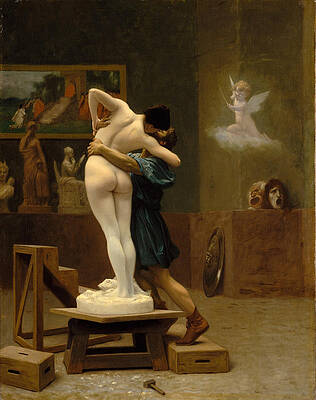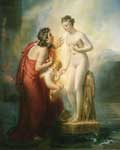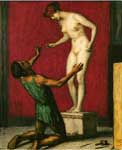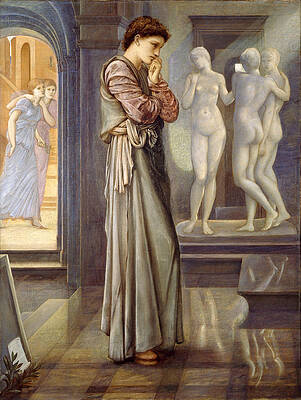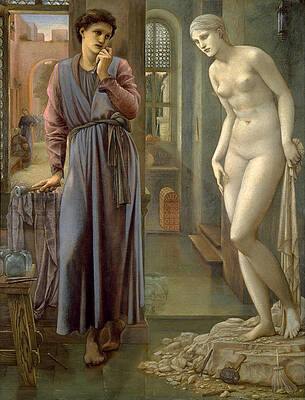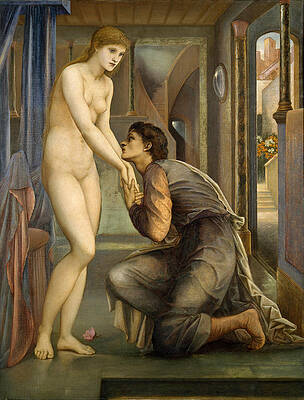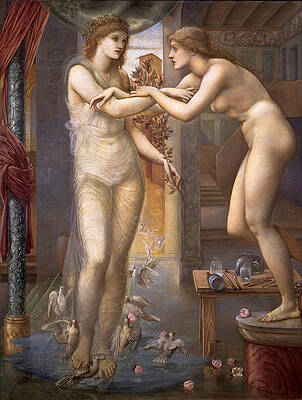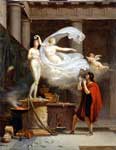.
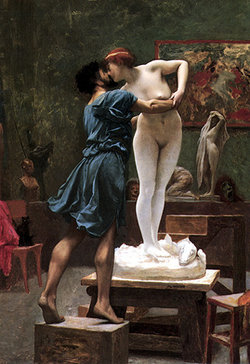
Pygmalion and Galatea 1881? by Jean-Léon Gérôme (1824-1904), one of two versions in which Galatea is shown frontal nude whereas a later less provocative version shows Galatea's backside.
Pygmalion (Πυγμαλίων) is a mythological figure found in Ovid's Metamorphoses. Pygmalion is a sculptor who falls in love with a statue he has made.
Pygmalion was a Cypriot sculptor who carved a woman out of ivory. According to Ovid, after seeing the Propoetides prostituting themselves, he is 'not interested in women', but his statue is so realistic that he falls in love with it. He offers the statue presents and eventually prays to Venus. She takes pity on him and brings the statue to life. They marry and have a son, Paphos.[1]
Ovid's mention of Paphos suggests he was drawing on the brief account of Pygmalion and Galatea in Bibliotheke, a Hellenic mythography formerly attributed to Apollodorus.
Parallels in the technology of the time
It tells a story of a sculptor who falls in love with a statue he has made. Pygmalion, son of Belus, was a lonely sculptor who carved a woman out of ivory. He prayed to Venus, the goddess of beauty and love, who took pity on him and brought the statue to life. Paphos was the product of the union between Pygmalion and the ivory statue.
The story has parallels in the example of Daedalus, who uses quicksilver to install a voice in his statues; and of Hephaestus who creates automata for his workshop, Talos, an artificial man of bronze, and, according to Hesiod, Pandora— from clay, at the behest of Zeus.
The discovery of the Antikythera mechanism suggests that such mythical animated statues had some grounding in contemporary mechanical technology. The island of Rhodes was particularly known for its displays of mechanical engineering and automata - Pindar,one of the nine lyric poets of ancient Greece, said this of Rhodes in his seventh Olympic Ode:
"The animated figures stand
Adorning every public street
And seem to breathe in stone, or
move their marble feet."
Greek sources of the myth
The Greek sources of Ovid's tale are fully discussed at Galatea.
Re-interpretations of Pygmalion
The basic Pygmalion story has been widely transmitted and re-presented in the arts through the centuries. At an unknown date, later authors give the name of the statue as the sea-nymph Galatea or Galathea. Goethe calls her Elise, based upon the variants in the story of Dido/Elissa.
In the Middle Ages Pygmalion was held up as an example of the excesses of idolatry, probably spurred by Clement of Alexandria's suggestion that Pygmalion had carved an image of Aphrodite herself. Although, by the 18th century it was a highly influential love-story, seen as such in Rousseau's musical play of the story. By the 19th century, the story often becomes one in which the awakened beloved rejects Pygmalion; although she comes alive, she is initially cold and unattainable.
A twist on this theme can also be seen in the story of Pinocchio where a wooden puppet is transformed into a real boy, though in this case the puppet possesses sentience prior to its transformation, and it is the puppet and not the woodcarver (sculptor) who beseeches the miracle.
Paintings
Pygmalion and the Image - The Heart Desires, Edward Burne-Jones
Pygmalion and the Image - The Hand Refrains, Edward Burne-Jones
Pygmalion and the Image - The Soul Attains, Edward Burne-Jones
Pygmalion and the Image - The Godhead Fires, Edward Burne-Jones
The story has been the subject of notable paintings by Jean-Léon Gérôme, Honoré Daumier, Edward Burne-Jones (four major works from 1868-1870, then again in larger versions from 1875-1878), Auguste Rodin, Ernest Normand, Paul Delvaux, Francisco Goya, Franz von Stuck, Francois Boucher, and Thomas Rowlandson, among others. There have also been numerous sculptures of the 'awakening'
Pygmalion, 1939, Delvaux, Paul (Belgian, 1897-1994) , Musées Royaux des Beaux-Arts, Brussels.
Literature
Ovid's Pygmalion has also provided inspiration for several works of literature, including William Morris's Earthly Paradise, and Friedrich Schiller's Ideals. Both Morris and Schiller described the statue as made of marble. The myth also formed the inspiration for Galatea 2.2, a novel by Richard Powers and Carol Ann Duffy's poem Pygmalion's Bride. The story is also referenced in Nathanial Hawthorne's "The Birthmark".
Opera and music
Pygmalian is the subject of Jean-Philippe Rameau's 1748 opera. It was also the subject of Gaetano Donizetti's first opera, Il Pigmalione.
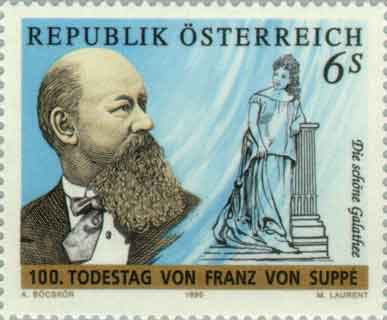
Die schöne Galathee
operetta
A modern interpretation of the story of Pygmalion is from the English progressive rock group Yes. They composed the song "Turn Of The Century" on 1977's Going For The One. With the music written by drummer Alan White and lyrics by singer Jon Anderson, it tells the story of the sculpter Roan who, in the grief of his wife's death, "molds his passion into clay." The sculpture of his wife comes to life and they fall in love.
Beautiful Galatea. a comic mythological opera in one act by `Poly Henrion' (L Kohl von Kohlenegg). Music by Franz von Suppé.
Stage plays
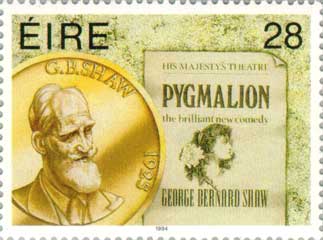
There have also been successful modern stage-plays based upon the work, such as W. S. Gilbert's Pygmalion and Galatea (1871).
George Bernard Shaw's Pygmalion (1912, staged 1914) owes something to both the Greek Pygmalion the legend of "King Cophetua and the beggar maid"; in which a King lacks interest in women, but one day falls in love with a young beggar-girl, later educating her to be his Queen. Shaw's tragedy in turn was the basis for the comedic Broadway musical My Fair Lady (1956).
Films
Notable 20th century feature films are My Fair Lady (1964, based on the stage play); Mighty Aphrodite by director Woody Allen; and the film Mannequin, a remake of the 1948 classic One Touch of Venus, as well as S1m0ne (featuring a computer-generated AI as the love object).
The popular horror genre in film has also had an interest in 'bringing to life' waxwork figures and show-room dummies (see: Waxworks: A Cultural Obsession by Michelle Bloom). Many horror films deviate considerably from the original story; for example, in The Stepford Wives (1975) the creators turn their living wives into inanimate (robotic, compliant) wives. Likewise, the myth serves as the inspiration for one of the Lineages, the Galatea, that appears in the White Wolf role-playing game Promethean: The Created.
Pygmalion , 1938 Film
Stamps
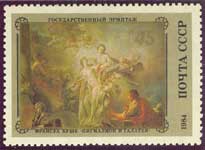
Pygmalion and Galatea, 1984
Television
The American TV series My Living Doll portrayed a female robot whose creators attempted to transform her into a "perfect woman".
Notes
- ^ "...the woman bore a son, Paphos, from whom the island takes its name." Ovid, Metamorphoses X.297
Further reading
- Essaka Joshua. (2001). Pygmalion and Galatea: The History of a Narrative in English Literature. Ashgate.
- Kenneth Gross. (1992). The Dream of the Moving Statue. Cornell University Press. (A wide-ranging survey of 'living statues' in literature and the arts).
- Jack Burnham. Beyond Modern Sculpture (1982). Allan Lane. (A history of 'living statues' and the fascination with automata - see the introductory chapter: "Sculpture and Automata").
- Ernst Buschor. Vom Sinn der griechischen Standbilder (1942). (Clear discussion of attitudes to sculptural images in classical times).
- Gail Marshall. (1998). Actresses on the Victorian Stage: Feminine Performance and the Galatea Myth. Cambridge University Press.
- Alexandra K. Wettlaufer. (2001). Pen Vs. Paintbrush: Girodet, Balzac, and the Myth of Pygmalion in Post-Revolutionary France. Palgrave Macmillan.
- Danahay, Martin A. (1994) "Mirrors of Masculine Desire: Narcissus and Pygmalion in Victorian Representation". Victorian Poetry, No. 32, 1994: pages 35-53.
- Edward A. Shanken. (2005) “Hot 2 Bot: Pygmalion’s Lust, the Maharal’s Fear, and the Cyborg Future of Art,” Technoetic Arts 3:1: 43-55. http://artexetra.com/Hot2Bot.pdf
- (2005). Almost Human: Puppets, Dolls and Robots in Contemporary Art, Hunterdon Museum of Art, Clinton, NJ. (Catalogue for a group exhibition Mar 20 - Jun 12 2005)
Pygmalion effect
Greek Mythology
See also : Greek Mythology. Paintings, Drawings
Greek Mythology Index
A - B - C - D - E - F - G - H - I - J - K - L - M -
N - O - P - Q - R - S - T - U - V - W - X - Y - Z
Α - Β - Γ - Δ - Ε - Ζ - Η - Θ - Ι - Κ - Λ - Μ -
Ν - Ξ - Ο - Π - Ρ - Σ - Τ - Υ - Φ - Χ - Ψ - Ω
| Ancient Greece
Science, Technology , Medicine , Warfare, , Biographies , Life , Cities/Places/Maps , Arts , Literature , Philosophy ,Olympics, Mythology , History , Images Medieval Greece / Byzantine Empire Science, Technology, Arts, , Warfare , Literature, Biographies, Icons, History Modern Greece Cities, Islands, Regions, Fauna/Flora ,Biographies , History , Warfare, Science/Technology, Literature, Music , Arts , Film/Actors , Sport , Fashion --- |
Retrieved from "http://en.wikipedia.org"
All text is available under the terms of the GNU Free Documentation License

